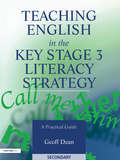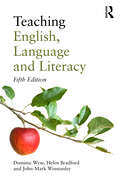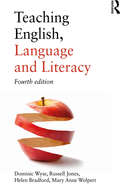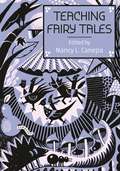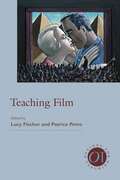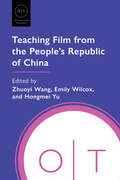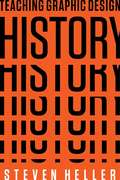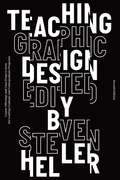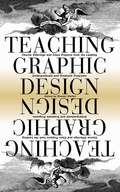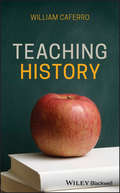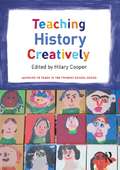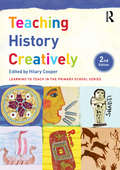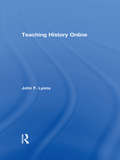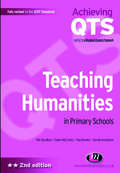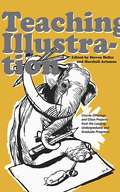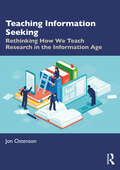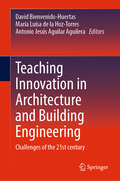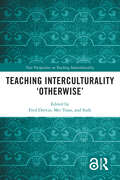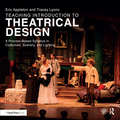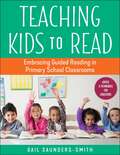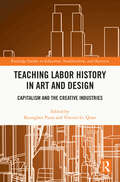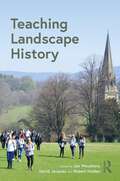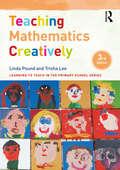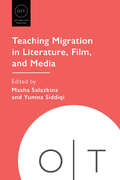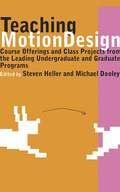- Table View
- List View
Teaching English in the Key Stage 3 Literacy Strategy
by Geoff DeanThis book will supplement the training currently being offered to all secondary English departments. It offers a view of the place of the English 'strand' in the overall Key Stage 3 strategy and gives support to English departments in their preparations for a new way of working. It will encourage English teachers to review their current schemes of work, offering suggestions for more substantial teaching and learning modules, as well as practical ideas for classroom use and recommended resources. The book interprets and explains the NLS document for busy practitioners; reinforces the messages of the National Literacy Strategy (NLS); spells out the expectations of the framework and offer guidance on how to fulfil them; and describes and explains the types of teaching methods to improve students' learning. This book includes many practical ideas for classroom activities and offers direct support for the less confident English teacher. The book is equally valuable to students and practicing teachers.
Teaching English, Language and Literacy
by Dominic Wyse Helen Bradford John-Mark WinstanleyAre you looking for one book that gives a comprehensive account of primary/elementary and early years English, language and literacy teaching? Based on robust research evidence and practical examples of effective teaching, this essential textbook critically evaluates curriculum policies and provides guidance for teachers on implementation of evidence-based teaching in classrooms. This fully revised fifth edition has a brand new chapter on Reading for Pleasure, and has substantially rewritten chapters to reflect recent developments in research, evaluations of new policy directions, and new practical examples of teaching and learning. The authors draw on their research, scholarship and practice to offer advice on: • inclusion and equality, including working effectively with multilingual pupils • the importance of talk and interaction • developing reading, including motivating children to read and phonics teaching • improving writing, including grammar and punctuation • planning and assessing • the latest educational policy and practice This authoritative book is an essential introduction for anyone who teaches English, language and literacy from the early years to primary school level, and seeks to improve their professional practice. Designed to help inform trainee teachers and tutors, but also of great use to those teachers wanting to keep pace with the latest developments in their specialist subject, this is an indispensable guide to the theory and practice of teaching English, language and literacy.
Teaching English, Language and Literacy (Routledge International Handbooks Of Education Ser.)
by Dominic Wyse Russell Jones Helen Bradford Mary Anne WolpertAre you looking for one book that gives a comprehensive account of primary and early years English, language and literacy teaching? This fully revised fourth edition of Teaching English, Language and Literacy includes up-to-date research and updated discussion of effective teaching. Throughout the book there is guidance on England’s new National Curriculum and its impact. Rooted in research evidence and multidisciplinary theory, this book is an essential introduction for anyone learning to teach English from the early years to primary school level. The authors draw on their research, scholarship and practice to offer advice on: inclusion and equality, including working effectively with multilingual pupils speaking and listening developing reading, including choosing texts, and phonics teaching improving writing, including grammar and punctuation planning and assessing the latest thinking in educational policy and practice the use of multimedia maintaining good home--school links All the chapters include examples of good practice, coverage of key issues, analysis of research and reflections on national policy to encourage the best possible response to the exciting challenges of teaching. Each chapter also has a glossary to explain terms and gives suggestions for further reading. This authoritative book is for all those who want to improve the teaching of English, language and literacy in schools. Designed to help inform trainee teachers and tutors, but also of great use to those teachers wanting to keep pace with the latest developments in their specialist subject, this is an indispensable guide to the theory and practice of teaching English, language and literacy.
Teaching Fairy Tales (Series in Fairy-Tale Studies)
by Gioia Timpanelli Cristina Mazzoni Allison Stedman Ann Schmiesing Jennifer Schacker Prof. Nancy L. Canepa Prof. Jack Zipes Dean Donald Haase Lewis C. Seifert Prof. Anne E. Duggan Professor Maria Nikolajeva Prof. Cristina Bacchilega Associate Professor Christine A. Jones Julie L. Koehler Kay Stone Prof. Maria Tatar Prof. Victoria Somoff Prof. Gina Miele Prof. Linda Kraus Worley Prof. Faith E. Beasley Prof. Charlotte Trinquet du Lys Prof. Benjamin Balak Prof. Suzanne Magnanini Dr Maria Kaliambou Prof. Elio Brancaforte Prof. William Moebius Prof. Graham AndersonTeaching Fairy Tales edited by Nancy L. Canepa brings together scholars who have contributed to the field of fairy-tale studies since its origins. This collection offers information on materials, critical approaches and ideas, and pedagogical resources for the teaching of fairy tales in one comprehensive source that will further help bring fairy-tale studies into the academic mainstream. The volume begins by posing some of the big questions that stand at the forefront of fairy-tale studies: How should we define the fairy tale? What is the "classic" fairy tale? Does it make sense to talk about a fairy-tale canon? The first chapter includes close readings of tales and their variants, in order to show how fairy tales aren’t simple, moralizing, and/or static narratives. The second chapter focuses on essential moments and documents in fairy-tale history, investigating how we gain unique perspectives on cultural history through reading fairy tales. Contributors to chapter 3 argue that encouraging students to approach fairy tales critically, either through well-established lenses or newer ways of thinking, enables them to engage actively with material that can otherwise seem over-familiar. Chapter 4 makes a case for using fairy tales to help students learn a foreign language. Teaching Fairy Tales also includes authors’ experiences of successful hands-on classroom activities with fairy tales, syllabi samples from a range of courses, and testimonies from storytellers that inspire students to reflect on the construction and transmission of narrative by becoming tale-tellers themselves. Teaching Fairy Tales crosses disciplinary, historical, and national boundaries to consider the fairy-tale corpus integrally and from a variety of perspectives. Scholars from many different academic areas will use this volume to explore and implement new aspects of the field of fairy-tale studies in their teaching and research.
Teaching Film (Options for Teaching #35)
by Patricia White Mark Lynn Anderson Adam Lowenstein Hamid Naficy Dudley Andrew Timothy Corrigan Anne Rutherford Tasha Oren Garrett Stewart E. Ann Kaplan Gwendolyn Audrey Foster Michael Renov Pat Brereton David Desser Maureen Turim Paula J. Massood Michael Aronson Nataša Ďurovičová Mark LangerFilm studies has been a part of higher education curricula in the United States almost since the development of the medium. Although the study of film is dispersed across a range of academic departments, programs, and scholarly organizations, film studies has come to be recognized as a field in its own right. In an era when teaching and scholarship are increasingly interdisciplinary, film studies continues to expand and thrive, attracting new scholars and fresh ideas, direction, and research.Given the dynamism of the field, experienced and beginning instructors alike need resources for bringing the study of film into the classroom. This volume will help instructors conceptualize contemporary film studies in pedagogical terms. The first part of the volume features essays on theory and on representation, including gender, race, and sexuality. Contributors then examine the geographies of cinema and offer practical suggestions for structuring courses on national, regional, and transnational film. Several essays focus on interdisciplinary approaches, while others describe courses designed around genre (film noir, the musical), mode (animation, documentary, avant-garde film), or the formal elements of film, such as sound, music, and mise-en-scène. The volume closes with a section on film and media in the digital age, in which contributors discuss the opportunities and challenges presented by access to resources, media convergence, and technological developments in the field.
Teaching Film from the People's Republic of China (Options for Teaching)
by Zhuoyi Wang, Emily Wilcox, and Hongmei YuThis volume brings a diverse range of voices--from anthropology, communication studies, ethnomusicology, film, history, literature, linguistics, sociology, theater, and urban geography--into the conversation about film from the People's Republic of China. Essays seek to answer what films can reveal or obscure about Chinese history and society and demonstrate how studying films from the PRC can introduce students to larger issues of historical consciousness and media representation.The volume addresses not only postsocialist fictional films but also a wide variety of other subjects including socialist period films, documentaries, films by or about people from ethnic minority groups, film music, the perspectives of female characters, martial arts cinema, and remakes of South Korean films. By exploring how films represent power, traditions, and ideologies, students learn about both the complexity of the PRC and the importance of cross-cultural and cross-ideological understanding.
Teaching Graphic Design History
by Steven HellerAn Examination of the Practice Through the Years Teaching the history of graphic design cannot simply be outlined by dates nor confined by places, but is defined by concepts and philosophies, as well as those who made, make, and inspire them. Teaching Graphic Design History is the first collection of essays, syllabi, and guides for conveying the heritage of this unique practice, from traditional chronologies to eclectic themes as developed by today’s historians, designers, scholars, and documentarians. Long overlooked within the broader history of printing and typesetting, when graphic design’s artifacts finally became the subject of serious study, the historian had to determine what was worthy and on what the history of graphic design should focus: the makers or the artifacts, the content or the context, or all of the above. With the author’s distinct viewpoint and many exclusive contributions, Teaching Graphic Design History chronicles the customs and conventions of various cultures and societies and how they are seen through signs, symbols, and the artifacts designed for use in the public—and sometimes private—sphere. Areas of focus include: Social and political effects of graphic designPhilosophical perspectives on designEvolution of brandingDevelopment of the graphic design professionPredictions for the future of the practice An examination of the concerted efforts, happy accidents, and key influences of the practice throughout the years, Teaching Graphic Design History is an illuminating resource for students, practitioners, and future teachers of the subject.
Teaching Graphic Design: Course Offerings and Class Projects from the Leading Graduate and Undergraduate Programs
by Steven HellerMore Than Sixty Course Syllabi That Bring the New Complexity of Graphic Design to Light All graphic designers teach, yet not all graphic designers are teachers. Teaching is a special skill requiring talent, instinct, passion, and organization. But while talent, instinct, and passion are inherent, organization must be acquired and can usually be found in a syllabus. Teaching Graphic Design, Second Edition, contains syllabi that are for all practicing designers and design educators who want to enhance their teaching skills and learn how experienced instructors and professors teach varied tools and impart the knowledge needed to be a designer in the current environment. This second edition is newly revised to include more than thirty new syllabi by a wide range of professional teachers and teaching professionals who address the most current concerns of the graphic design industry, including product, strategic, entrepreneurial, and data design as well as the classic image, type, and layout disciplines. Some of the new syllabi included are: Expressive Typography Designer as Image Maker Emerging Media Production Branding Corporate Design Graphic Design and Visual Culture Impact! Design for Social Change And many more Beginning with first through fourth year of undergraduate courses and ending with a sampling of graduate school course options, Teaching Graphic Design, Second Edition, is the most comprehensive collection of courses for graphic designers of all levels.
Teaching Graphic Design: Course Offerings and Class Projects from the Leading Graduate and Undergraduate Programs
by Steven HellerThis priceless teaching tool features more than 70 proven-effective programs from the country's leading graphic design schools. <P><P>Spanning from traditional, "bricks and mortar" approaches to the ever-widening digital frontier of graphic design, these syllabi include detailed introductions, weekly breakdowns, project suggestions, and selected readings, as well as offer valued background material on the history, social responsibility, and cultural impact of design. More than an instructor's guide, Teaching Graphic Design is a self-contained chronicle of the past, present, and future of the art and the industry.
Teaching History
by William CaferroA practical and engaging guide to the art of teaching history Well-grounded in scholarly literature and practical experience, Teaching History offers an instructors’ guide for developing and teaching classroom history. Written in the author’s engaging (and often humorous) style, the book discusses the challenges teachers encounter, explores effective teaching strategies, and offers insight for managing burgeoning technologies. William Caferro presents an assessment of the current debates on the study of history in a broad historical context and evaluates the changing role of the discipline in our increasingly globalized world. Teaching History reveals that the valuable skills of teaching are highly transferable. It stresses the importance of careful organization as well as the advantages of combining research agendas with teaching agendas. Inspired by the Scholarship of Teaching and Learning movement, the book encourages careful reflection on teaching methods and stresses the importance of applying various approaches to promote active learning. Drawing on the author’s experience as an instructor at the high school and university levels, Teaching History: Contains an authoritative and humorous look at the profession and the strategies and techniques of teaching history Incorporates a review of the current teaching practice in terms of previous methods, examining nineteenth and twentieth century debates and strategies Includes a discussion of the use of technology in the history classroom, from the advent of course management (Blackboard) systems to today’s digital resources Covers techniques for teaching the history of any nation not only American history Written for graduate and undergraduate students of history teaching and methods, historiography, history skills, and education, Teaching History is a comprehensive book that explores the strategies, challenges, and changes that have occurred in the profession.
Teaching History Creatively
by Hilary CooperFresh and innovative, Teaching History Creatively will foster creativity in both learners and practitioners alike. By introducing teachers to a wealth of available approaches to historical enquiry, this book ensures creative, active and effective learning which includes plenty of challenges, clear goals and opportunity for progression. Underpinned by theory and research, it offers informed and practical support, illustrated throughout by examples of children’s work. Key themes addressed include: how good history education and creativity are inseparable; investigating sources: archaeology, visits and time capsules; using archives in your own research project; historical agents and history detectives!; drama for exploring events, myths and legends; communicating historical understanding creatively. Written by experienced authors with extensive experience of history teaching in the primary school, Teaching History Creatively is an essential purchase for any professional who wishes to embed creative approaches to teaching in their classroom.
Teaching History Creatively (Learning To Teach In The Primary School Ser.)
by Hilary CooperThe fully updated second edition of Teaching History Creatively introduces teachers to the wealth of available approaches to historical enquiry, ensuring creative, effective learning. This book clearly sets out the processes of historical enquiry, demonstrating how these are integrally linked with key criteria of creativity and helps readers to employ those features of creativity in the classroom. Underpinned by theory and research, it offers informed and practical support and is illustrated throughout with examples of children’s work. Key themes addressed include: investigating sources using archives in your own research project becoming historical agents and history detectives drama for exploring events myths and legends communicating historical understanding creatively. With brand new chapters from the Stone Ages to the Iron Age, using prehistoric sources; The withdrawal of the Romans and the conquest and settlement of Britain by the Anglo-Saxons, in addition to many new case studies, this exciting edition puts an emphasis on accessible, recent research, new evidence and interpretations and encourages the creative dynamism of the study of history. Teaching History Creatively provides vivid and rich examples of the creative use of sources, of approaches to understanding chronology and concepts of time and of strategies to create interpretations. It is an essential purchase for any teacher or educator who wishes to embed creative approaches to teaching history in their classroom.
Teaching History Online
by John F. LyonsBringing history teaching into the twenty-first century, Teaching History Online is a concise guide to developing and using internet resources in history instruction. It offers practical, jargon-free advice to help the history teacher develop online assignments, and provides an informed introduction to the myriad resources and tools available for use in the online classroom. Beginning with a chapter on the benefits of teaching and studying online, John F. Lyons goes on to address instructors’ most commonly asked questions and concerns, including: designing an online class providing online alternatives to the lecture developing a user-friendly discussion board conducting assessment and dealing with classroom management issues. For historians interested in providing an online element to their traditional face-to-face classroom teaching, the final chapter shows how to develop successful hybrid/blended classes. An accessible introduction and valuable resource, Teaching History Online includes sample lesson plans, examples of online learning tools, and suggestions for further reading, helping those who use – or want to use – online resources to create exciting, interactive and rewarding learning environments. Visit the companion website, which includes extra reading and resources information at: www.routledge.com/textbooks/9780415482226.
Teaching Humanities in Primary Schools (Achieving QTS Series)
by Pat Hoodless Paul Bowen Susan Bermingham Elaine McCreeryThis book supports primary trainees in their learning and teaching approach to the core humanities subjects: geography, history and religion. It promotes an integrated approach to these subject areas and encourages trainees to reflect on the links between subjects, across the curriculum from the Early Years Foundation Stage through to Key Stage 2. This edition has been updated to incorporate the revised Professional Standards for the Award of QTS and addresses key initiatives such as Excellence and Enjoyment, Every Child Matters and the Primary National Strategy for Literacy and Mathematics.
Teaching Illustration: Course Offerings and Class Projects from the Leading Graduate and Undergraduate Programs
by Steven Heller Marshall ArismanTeaching Illustration is a must-have for any college-level art instructor. Packed with a wealth of illustration course syllabi from leading art and design schools across the U.S. and Europe, it offers exciting ideas on topics from editorial illustration to animation, books, and the Internet. Each syllabus includes an introduction, course requirements, a weekly breakdown, suggestions for projects, and selected readings-a comprehensive array of topics, reading lists, and teaching tips for courses at all levels. For beginning educators seeking guidance or for veterans seeking new inspiration, Teaching Illustration is essential for the craft of teaching the next generation of illustrators. Packed with sample syllabi-a must-have for art teachers and students Detailed, concrete examples of how to create compelling, inspiring classes
Teaching Information Seeking: Rethinking How We Teach Research in the Information Age
by Jon OstensonTeaching Information Seeking redefines how we approach research and information literacy in today's information-rich world, inviting teachers to re-imagine teaching research.The book combines insights from fields such as library and information sciences, journalism, and media literacy to offer fresh strategies and perspectives for guiding students through evolving landscapes of information.While a focus on concepts and skills has long been important in teaching research, this book integrates significant new understandings about the role dispositions play in how well students embrace and utilize skill-based knowledge. The book provides conceptual knowledge and learning activities that support writing teachers as they help students learn throughout the research or inquiry process of asking questions, finding information, and sharing their learning purposefully and ethically. Chapters with a pedagogical focus and approach include activities informed by the author’s decades of experience teaching writing. These activities are described in depth, including assignment prompts, sample work, and scripts for think-aloud protocols and discussions the author has led that engage students in deeper learning around these critical skills and dispositions. Teaching Information Seeking serves as a comprehensive guide for educators looking to foster meaningful information literacy and critical thinking skills in their students.This book is ideal for teachers and teacher educators who want to equip students with the skills and dispositions needed for effective research and information literacy. Readers will find teacher-friendly, research-grounded insights and activities that can be readily applied in the classroom.
Teaching Innovation in Architecture and Building Engineering: Challenges of the 21st century
by David Bienvenido-Huertas María Luisa de la Hoz-Torres Antonio Jesús Aguilar AguileraThis book presents contributions on teaching innovation in university architecture and building engineering studies. The authors explain how the construction sector demands that future architects and building engineers have the knowledge and skills that allow them to meet the decarbonization objectives established by international organizations and that this causes the level of knowledge to be higher. The contributors further discuss new technologies and the internationalization of studies presenting new challenges university studies must face. This heterogeneity is represented in the chapters that make up this book developed by researchers from different countries. The book is divided into three blocks: (i) Active learning methodologies; (ii) Innovative methodologies applied to learning process; and (iii) Traditional vs. Advanced Techniques. The chapters of the book represent an advance in the current knowledge of teaching innovation techniques in university architecture and building engineering studies.
Teaching Interculturality 'Otherwise' (New Perspectives on Teaching Interculturality)
by Fred Dervin, Mei Yuan, and SudeThis edited volume focuses on the thorny and somewhat controversial issue of teaching (and learning) interculturality in a way that considers the notion from critical and reflexive perspectives when introduced to students. Comprised of three parts, the book discusses the nuts and bolts of teaching interculturally, considers changes in the teaching of interculturality, and provides pedagogical insights into interculturalising the notion. It studies both teaching im-/explicitly about interculturality and how to incorporate interculturality into teaching practices or into an institution. By sharing varied cases and theoretical reflections on the topic, the editors and contributors from different parts of the world aim to stimulate more initiatives to enrich the field instead of delimiting it, especially in complement to and beyond the 'West' or 'Global North', and also to build up further reflexivity in the way readers engage with interculturality in education. This will be a must-read for teachers and researchers of intercultural communication education at different educational levels, as well as anyone interested in scholarship on education for interculturality.
Teaching Introduction to Theatrical Design: A Process Based Syllabus in Costumes, Scenery, and Lighting
by Eric Appleton Tracey LyonsTeaching Introduction to Theatrical Design is a week-by-week guide that helps instructors who are new to teaching design, teaching outside of their fields of expertise, or looking for better ways to integrate and encourage non-designers in the design classroom. This book provides a syllabus to teach foundational theatrical design by illustrating process and application of the principals of design in costumes, sets, lights, and sound.
Teaching Kids to Read: Embracing Guided Reading in Primary School Classrooms
by Gail Saunders-Smith"A solid resource to help teachers understand the basic foundation for literacy development through guided reading in the primary grade." —Patti Ulshafer, first-grade teacherDevelop successful readers with these strategies for before, during, and after reading. In Teaching Kids to Read, Gail Saunders-Smith describes the cognitive processes of emergent readers and provides educators with clear guidelines for promoting reading comprehension with small groups of young learners. A variety of exercises included helps children to locate, record, retrieve, and manipulate information from texts while enabling teachers to measure how students respond in oral, written, graphic, and three-dimensional forms. Topics covered include:AliteracyCoaching statementsElements of craftFalse positive readersFresh textGuided readingInstructional practiceMetacognitionPhonemic awarenessSelf-monitoringShared readingSight wordsStudy skillsTeacher talkWorkable wordsand more!
Teaching Labor History in Art and Design: Capitalism and the Creative Industries (Routledge Studies in Education, Neoliberalism, and Marxism)
by Kyunghee Pyun Vincent G. QuanDrawing from American history, fashion design, history of luxury, visual culture, museum studies, and women’s history, among others, this book explores the challenges, rewards and benefits of teaching business and the labor history of art and design professions to those in higher education.Recognizing that artists and designers are no longer just creatives, but bosses, employees, members of professional associations, and citizens of nations that encourage and restrain their creative work in various ways, the book identifies a crucial need for art and design students to be taught the intricacies of these other roles, as well as how to navigate or challenge them. This empirically driven study features case studies in various pedagogical contexts, including museum exhibitions, group projects, lesson plans, discussion topics, and long-term assignments. The chapters also explore how the roles of designing and making became separated, how new technologies and the rise of mass production affected creative careers, the shifts back and forth between direct employment and freelancing, and the evolution of government interventions in creative fields.With a diverse and experienced range of contributors, and providing a unique set of conceptual tools to interpret, cope with, and react to the ever-changing conditions of capitalism, this volume will appeal to educators and researchers across education, history, art history, and sociology, with interests in experiential learning, capitalism, equity, social justice and neoliberalism.
Teaching Landscape History
by Jan Woudstra David JacquesLandscape history is changing in content and style to address the issues of today. Experienced teachers and authors on the history of gardens and landscapes come together in this new volume to share ideas on the future of teaching history in departments of landscape architecture, archaeology, geography and allied subjects. Design history remains important, but this volume brings to the fore the increasing importance of environmental history, economic history, landscape history, cultural landscapes, environmental justice and decolonisation, ideas of sustainability and climate change amelioration, which may all be useful in serving the needs of a widening range of students in an increasingly complex world. The main themes include: what history should we narrate in the education of landscape architects? how can we recognise counter-narratives and our own bias? how should we engage the students in the history of their chosen profession? how can designers and researchers be persuaded of the relevance of history teaching to theory and practice? and what resources do we need to develop teaching of landscape histories? This book will be of interest to anyone teaching courses on landscape architecture, urban design, horticulture, garden design, architectural history, cultural geography and more.
Teaching Mathematics Creatively (Learning to Teach in the Primary School Series)
by Trisha Lee Linda PoundThis revised and updated third edition offers a range of strategies, activities and ideas to bring mathematics to life in the primary classroom. Taking an innovative and playful approach to maths teaching, this book promotes creativity as a key element of practice and offers ideas to help your students develop knowledge, understanding and enjoyment of the subject. In the creative classroom, mathematics becomes a tool to build confidence, develop problem solving skills and motivate children. The fresh approaches explored in this book include a range of activities such as storytelling, music and construction, elevating maths learning beyond subject knowledge itself to enable students to see mathematics in a new way. Key chapters of this book explore: • Learning maths outdoors - make more noise, make more mess or work on a larger scale • Everyday maths - making sense of the numbers, patterns, shapes and measures children see around them • Music and maths – the role of rhythm in learning, and music and pattern in maths Stimulating, accessible and underpinned by the latest research and theory, this is essential reading for trainee and practising teachers who wish to embed creative approaches to maths teaching in their classroom.
Teaching Migration in Literature, Film, and Media (Options for Teaching)
by Yumna Siddiqi Masha SalazkinaPeople migrate to seek opportunities, to unite with family, and to escape war, persecution, poverty, and environmental disasters. A phenomenon that has real, lived effects on individuals and communities, migration also carries symbolic, ideological significance. Its depiction in literature, film, and other media powerfully shapes worldviews, identities, attitudes toward migrants, and a political landscape that is both local and global. It is imperative, then, to connect the disciplinary and theoretical tools we have for understanding migration and to put them in conversation with students' experiences.Featuring a wide range of classroom approaches, this volume brings together topics that are often taught separately, including tourism, slavery, drug cartels, race, whiteness, settler colonialism, the Arab Spring, assimilation, and disability. Readers are introduced to terminology and legal frameworks and to theories of migration in relation to Black studies, ethnic studies, Asian American studies, Latinx studies, border studies, postcolonial studies, and Indigenous studies.
Teaching Motion Design: Course Offerings and Class Projects from the Leading Graduate and Undergraduate Programs
by Steven Heller Michael DooleyHow motion design is taught in more than 45 leading programs. * Detailed syllabi and descriptions of class projects and assignments * Go-to guide for professors and teachers planning their courses * Course plans from School of Visual Arts, Ohio State, Rochester Institute of Technology, many other top schools. This definitive study of motion design is essential reading for everyone teaching or studying design. Now, for the first time, authors Steven Heller and Michael Dooley present a comprehensive look at course offerings from more than 45 leading programs devoted to design, illustration, animation, and computer art. Taken together, they provide a close-up look at the principles and practices of 3D computer animation, character animation, pictorial background illustration, motion graphic design, interactive media, film design, and more, with class projects and syllabi from many of the most prestigious schools in the country. Organized in easy-to-use sections by year of study, this invaluable tool will be every graphic design educator's go-to guide.
